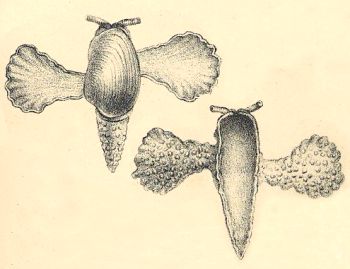
Lobiger souverbii
Fischer, 1856
Order: SACOGLOSSA
Superfamily: OXYNOOIDEA
Family: Oxynoidae
DISTRIBUTION
Caribbean, tropical, subtropical West Atlantic.
PHOTO
A copy of Fischer's illustration of Lobiger souverbii from Pilsbry, 1896: Pl. 10. figs 39, 42.
See messages below about Engel's emended spelling 'L. souverbiei' and about the relationship between L. souverbii and Lobiger viridis.
See Lobiger references.
Authorship detailsRudman, W.B., 2000 (October 6) Lobiger souverbii Fischer, 1856. [In] Sea Slug Forum. Australian Museum, Sydney. Available from http://www.seaslugforum.net/find/lobisouv
Related messages
Lobiger souverbii from the east Pacific
December 8, 2009
From: Kevin Lee
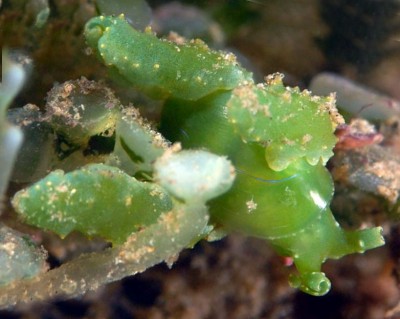
One more ulta-cryptic slug, L. souverbii, found by Eagle Eyes Ali. One of the parapodial lobes seems to be missing.
Locality: Mismaloya Beach, Puerto Vallarta, 25fsw, Mexico, East Pacific, 03 July 2009, Rocky Reef. Length: 3/8 inch. Photographer: Kevin Lee.
K:-)
diverkevin@gmail.com
Lee, Kevin, 2009 (Dec 8) Lobiger souverbii from the east Pacific. [Message in] Sea Slug Forum. Australian Museum, Sydney. Available from http://www.seaslugforum.net/find/22938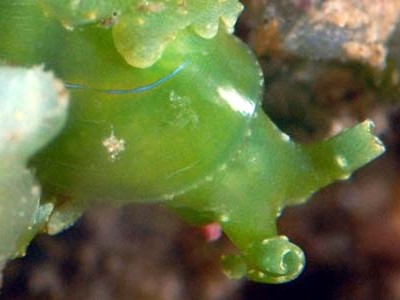
Dear Kevin,
By coincidence I have just posted a message [#22944] concerning Lobiger from eastern Australia, and as I discuss there, it seems to me there are still unanswered questions concerning whether the Caribbean L. souverbii and the Indo-West Pacific L. viridis are the same or different species. if your animal was from the Caribbean I would have no hesitation in identifying it as L. souverbii as that name was based on Caribbean animals and is older than L. viridis.
However if they turn out to be separate species we have the added complication that East Pacific animal could be either species, as a number of tropical American species occur on both sides of the Panama Isthmus, and a number of West Pacific species have been reported from the east Pacific coast of central America.
Best wishes,
Bill Rudman
Lobiger souverbii from St. Vincent
October 26, 2005
From: Les Wilk
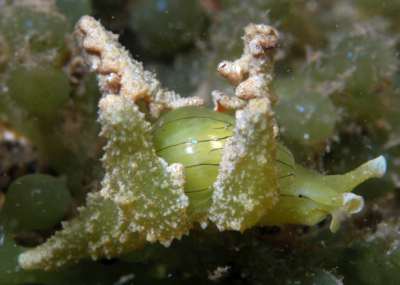
Hi Bill;
This specimen of Lobiger souverbii was found amongst sea grapes [Caulerpa ] on a mooring line in a quiet bay. This was the only one we saw during 5 weeks of diving on St. Vincent's west side.
Locality: Critter Corner, St. Vincent Is., Caribbean. Depth: 20 feet. Length: 1 inch. July 2005. sandy bottom. Photographer: Keri Wilk
Les Wilk
wilk@reefnet.ca
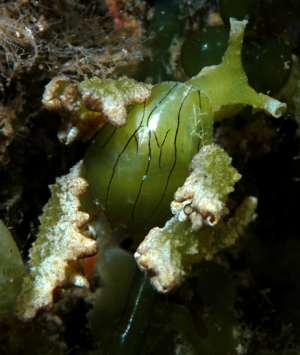
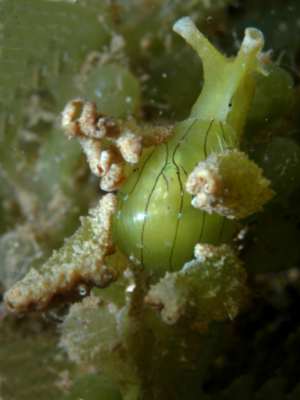
Dear Les,
Thanks for this. As I said in an earlier message [#3117], it would be nice to have more information about the shape of living Lobiger souverbii to see if it has any distinctive differences from its Indo-West Pacific counterpart, Lobiger viridis. It would be interesting to see some more photos of it 'unfurling' the four parapodial lobes. Do they just have rounded 'bumps' along the edge or do they have enrolled secondary lobes, like their Indo-West Pacific counterpart?. Your photos show signs of enrolled secondary lobes.Perhaps next time you encounter this animal you could gice it a gentle prod to see if it will unroll its lobes as I illustrate from Lobiger viridis on the Fact Sheet.
Best wishes,
Bill Rudman
Lobiger souverbii from the Bahamas
March 1, 2004
From: Colin Redfern
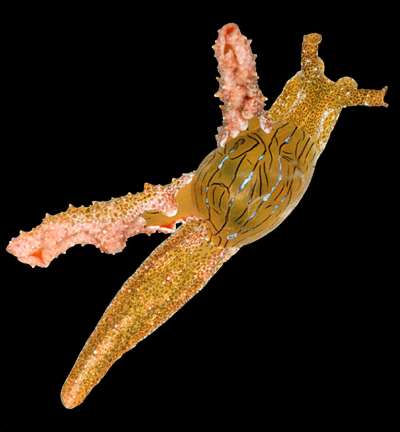
Dear Bill,
As the discussion concerning Lobiger souverbii and L. viridis seems to be an ongoing one, I thought you might like to have this photo of a large (19mm) specimen of L. souverbii that I collected recently from Abaco, Bahamas. There are only two lobes - I didn't manage to photograph these unfurled, but their interior was predominantly yellowish green, with a few narrow black lines. The orange coloration was confined to the margins.
Also attached is a photo of an egg mass that the animal deposited on the side of a glass container.
Length of body 19mm. On mixed algae dredged off the SE end of Whale Cay, Abaco, Bahamas in 9m. February 13, 2004.Best wishes,
Colin
bahamianseashells@att.net
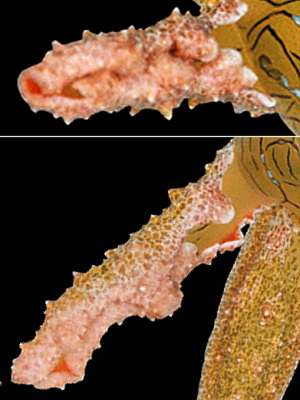
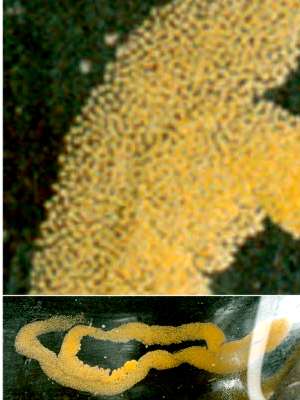
Thanks Colin,
I must say the distinction between the two species seems to be becoming a bit blurred. Perhaps this is one of those taxonomic problems which may need a look at the DNA. Certainly in your animal the parapodial lobes seem to have well developed secondary lobes
Best wishes
Bill Rudman
Lobiger souverbii from Jamaica
October 14, 2003
From: Ross W. Gundersen

Dear Bill:
Here is another sea slug from Jamaica. As I said in my first message, all specimens were collected from St. Ann's Bay, Jamaica, West Indies. Photo: R. Gundersen.
Here is Lobiger souverbii. Found on Caulerpa at 4 m depth.
Best wishes,
Ross
ross.gundersen@uwp.edu
Gundersen, R.W., 2003 (Oct 14) Lobiger souverbii from Jamaica. [Message in] Sea Slug Forum. Australian Museum, Sydney. Available from http://www.seaslugforum.net/find/11125Thanks Ross,
Bill Rudman
Lobiger souverbii from Bahia de Banderas
March 14, 2003
From: Alicia Hermosillo
Dear Bill,
Looks like Lobiger souverbii are back this year. We were a little concerned with some of the opisthobranch populations in Bahia de Banderas since the water temperature is 6 degrees warmer than usual for this time of the year.
Photo: 11mm long, 25 feet deep, Playa Mismaloya, Bahia de Banderas, Pacific Coast of Mexico.
Best wishes,
Ali
gueri25@hotmail.com
![]()
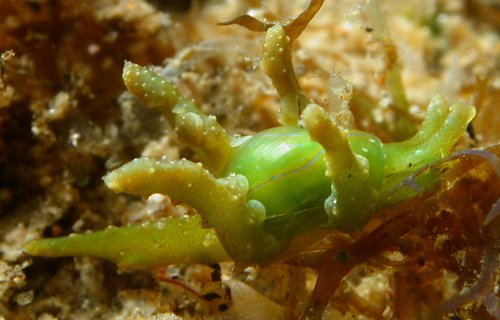
Dear Ali
Thanks for another photo to complement the ones in last year's message. The 'parapodial' lobes certainly seem to match the Caribbean animals so I guess it is Lobiger souverbii rather than a very eastern population of the Indo-West Pacific species, Lobiger viridis.
I understand the warm water in the eastern Pacific coincides with drought conditions in Australia. So I hope the water soon cools down because we could do with some decent rain.
Cheers,
Bill Rudman
Re: Lobiger from Gulf of Mexico
September 24, 2002
From: Nishina Masayoshi
Dear Bill,
This is an interesting photo. I am not sure whether this animal is L. souverbii or not, but on seeing this photo I feel L. viridis with a blue stripe on the shell in Japan such as in my animals and this Lobiger don't look as though they are the same species to me. This animal doesn't has the secondary rolled flaps, nor the reddish pink tips of the branches of the parapodial lobes which my Lobiger always have. Also, the series of dark spots which borders the edge of the shell is quite different. I don't think Lobiger in Hachijo Is. Japan has this [see earlier message].
Best Regards,
Nishina Masayoshi
nishina@wips.co.jp
Masayoshi, N., 2002 (Sep 24) Re: Lobiger from Gulf of Mexico. [Message in] Sea Slug Forum. Australian Museum, Sydney. Available from http://www.seaslugforum.net/find/8017Thanks Nishina,
As I've said previously, I think the lack of secondary 'flaps' on the parapodia of the Caribbean animal may be distinguishing feature, but we need more imformation. The marks around the shell border are the edge of the mantle from inside the shell which extends out and recurves up over the shell. This is sensitive tissue and is often retracted so it's not always visible. You can see it in the lower left photo of the Fact Sheet for Lobiger viridis.
Best wishes,
Bill Rudman
Lobiger from Gulf of Mexico
September 20, 2002
From: Anna L. Bass
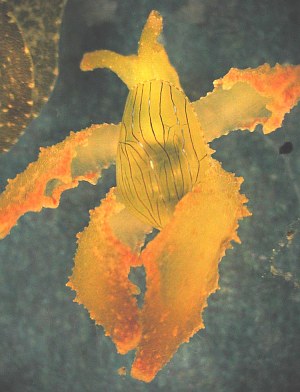
Hello Dr. Rudman,
This interesting animal tricked me. I thought it was a random piece of algae stuck in the corner of the tank. I was quite happy to see that it wasn't just algae. I believe it came in on Caulerpa racemosa, but am not positive. It is 1cm in length. Is it Lobiger viridis?
Regards,
Anna
abass@helios.acomp.usf.edu
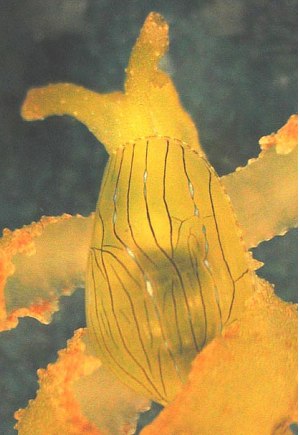
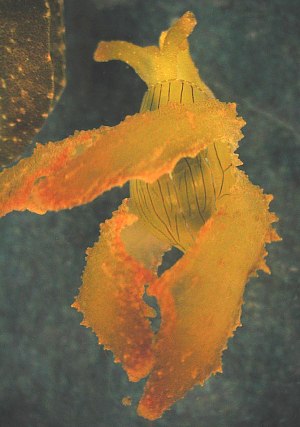
Dear Anna,
Thanks for these photos of the Caribbean Lobiger. As you will see amongst the messages on the Lobiger viridis page there is considerable confusion as to whether there is one circumtropical species or a separate Caribbean species. Until that is resolved I guess it is better to err on the side of conservatism and call the Caribbean species Lobiger souverbii. As it is the older name any way, that is what they all should be called if there turns out to be one species. One distinction I wondered about was that the Indo-West Pacific animals had secondary rolled flaps on their parapoda while the Caribbean animals just had a crenulated edge. Certainly your photos don't show the rolled secondary flaps but I don't know whether the difference is a constant feature in either the Caribbean or the IWP.
Best wishes,
Bill Rudman.
Lobiger souverbii from Bahia de Banderas
June 6, 2002
From: Ali Hermosillo
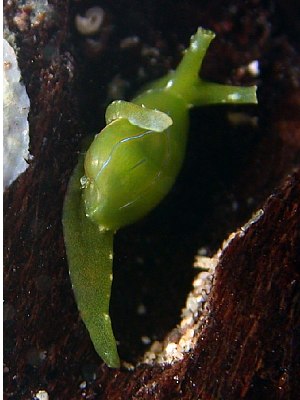
Dear Dr. Rudman,
Sandra Millen and Mike Miller were diving with a few weeks ago. Sandra and I were looking for sacoglossans in some species of Codium and Caulerpa with no luck. After they left, I went for another dive at Playa Mismaloya, Bahia de Banderas, Pacific Coast of Mexico. The past few weeks we had a dramatic rise in the water temperature which brought a rapid growth of alga all over.
This Lobiger souverbii was in a species of Caulerpa, 20 feet deep, 9 May 2002. Length: 7mm (there was a smaller one with it).
It only has one lobe, however, I do not know whether I caused it to autotomize the rest or this was done before I saw it.
I have read the identification of this species is confusing because the number of lobes it has. It autotomizes them rather easily. This one has only one, I do not know whether it lost the other when I collected it or was like that before. It is really small but you can see the characteristic blue lines on the shell. I like the lower right picture that shows it coiled under the Caulerpa as it shows just how hard they are to spot.
Ali
gueri25@hotmail.com


Dear Ali,
Thanks for the photos. Looking for cryptic sacoglossans on their food plants can be a soul destroying exercise. I remember the first time I visited the Great Barrier Reef and was looking for sacoglossans living on Caulerpa racemosa. I really wanted to see living bivalved gastropods for the first time. After a week's searching and it seemed many tons of Caulerpa I admitted defeat. To build up the museum's collections we used to wash samples of algae in dilute formalin and preserve to washings for lab investigation. Months later a technician came up to me and said how rich in bivalve sacoglossans our samples were - and the three of us in the field had not seen one of them alive!
Best wishes,
Bill Rudman
Lobiger souverbii from Caribbean
November 9, 2001
From: Bill Rudman

As background for the on-going discussion on Lobiger viridis here is some information on the Caribbean species Lobiger souverbii.
PHOTO: A copy of Fischer's illustration of Lobiger souverbii from Pilsbry, 1896: Pl. 10. figs 39, 42.
In Fischer's original description only 2 parapodial flaps were illustrated but this is based on a specimen in which 2 flaps have been autotomised. This species has crenulations along the edge of the parapodial flaps rather than secondary branches.
Bill Rudman
Rudman, W.B., 2001 (Nov 9) Lobiger souverbii from Caribbean. [Message in] Sea Slug Forum. Australian Museum, Sydney. Available from http://www.seaslugforum.net/find/5655Lobiger souverbii
October 7, 2000
From: Rosemary Milburn
Bill,
I'm trying to find out about the sea slug Lobiger souverbii. All I've been about to find out so far is that is covered in small bumps and can be found feeding on green weeds in shallow waters of the Papua New Guinea, Indonesia and the Solomon Islands.
Any info would be much appreciated!
Rosemary
Science editor,
New Holland Publishers
rosemary@newholland.com.au
Milburn, R., 2000 (Oct 7) Lobiger souverbii. [Message in] Sea Slug Forum. Australian Museum, Sydney. Available from http://www.seaslugforum.net/find/3117Dear Rosemary,
I am not sure if your interest is in Lobiger souverbii or in the Lobiger that is found in the southwest Pacific.
Lobiger souverbii was described from the Caribbean and has been reported in the tropical and subtropical waters of the western Atlantic as far south as Brazil. Some authors have decided that the Atlantic species is the same as the Indo-West Pacific species Lobiger viridis, but that opinion is by no means unanimous. Certainly both species are similarly coloured and can have dark blue lines on the mantle but there have been differences reported in the anatomy which need checking. One other external difference I think needs checking is the shape of the four parapodial extensions. In animals from the Indo-West Pacific, which I am familiar with, the four primary lobes have secondary lobes along each side. These can be clearly seen in my photos on the Lobiger viridis page. I have never seen Caribbean animals alive, but from drawings and photos there don't seem to be secondary lobes, although there is some crenulation along each edge.
If anyone familiar with Caribbean animals could send some photos, or even a description, it would be very interesting.
If your interest Rosemary, is in the Pacific species then go to the Lobiger viridis page where I discuss some features of this animal.
Best wishes,
Bill Rudman.
Lobiger souverbiei vs L. souverbii
October 7, 2000
From: Cynthia Trowbridge
Dear Bill,
I was wondering if you or any participant could assist me with spelling queries.
• 1. Lobiger souverbiei vs L. souverbii - which is correct and why? Is this a masculine/feminine topic or some other topic?
• 2. Polybranchia viride vs. P. viridis - again, which is correct and why?
• 3. Olea haniseënsis vs. O. haniseensis - - again, which is correct and why? The former was the original name in the species description (Agersborg 1923) but everyone else publishing on the species has used the latter spelling.
[AGERSBORG, H.P.K. 1923. Notes on a new cladohepatic nudibranch from Friday Harbor, Washington. The Nautilus, 36: 133-138.]
I guess the bottom line is to ask where I can look up this type of problem...? Any assistance would be much appreciated and also educational (at least to me).
All the best!
Cordially,
Cynthia
trowbric@ucs.orst.edu
Trowbridge, C., 2000 (Oct 7) Lobiger souverbiei vs L. souverbii. [Message in] Sea Slug Forum. Australian Museum, Sydney. Available from http://www.seaslugforum.net/find/3131Dear Cynthia,
Funny you should ask about L. souverbiei vs L. souverbii. I was just answering a question about this animal and was wondering about the two spellings myself. Fischer (1856) originally named the species Lobiger souverbii in honour of his friend Dr Souverbie. This spelling was used until Engel (1927) changed it to L. souverbiei. I have scanned through his paper but can't find why he changed the spelling. Since then some authors, the Marcuses in particular, have used Engel's spelling, while other authors have stuck with the original spelling. This is not a case of gender matching and is probably quite an unjustified emendation by Engel. Some later editions of the International Code, which of course appeared long after Fischer's day, did have recommendations about what endings should be applied to personal names, but they were never rules, just recommendations. If someone feels differently please let me know, but I can't find any justification for ignoring Fischer's original spelling. Unfortunately, as I have said before, we are biologists, not grammarians and linguists.
Your other two questions are much simpler: •2. Polybranchia viride is vernacular French which has no status in nomenclature. The latinised version Polybranchia viridis is the only valid name. French authors often used to give French names to species, often on the Plates, and the Latin name in the description.
•3. Olea haniseënsis vs. O. haniseensis. Firstly I think the spelling is hansineensis isn't it? The International Rules ban all diacritic marks, accents etc so ë becomes e etc.
If anyone knows of a good book on zoological nomenclature I would like to hear of it. There is the International Code of Zoological Nomenclature but like any code of laws you need to be a specialist or a specialist lawyer, to follow all the nuances, and understand how one clause affects another etc. And that is before you do your training in the grammar of two dead languages. The latest edition (4) of the Code is even less user friendly than earlier editions which use to have pages of recommendations, and tables explaining some grammatical points.
Hope I have answered the specific points you raised, but sorry I can't give much general information.
Best wishes,
Bill Rudman.
